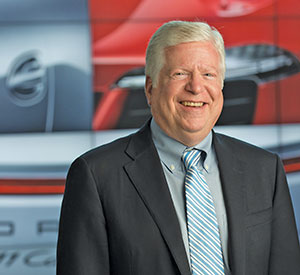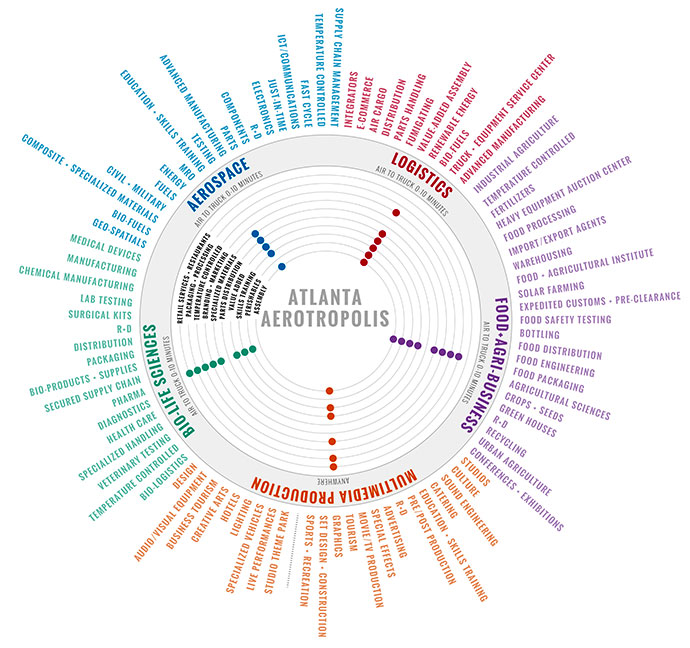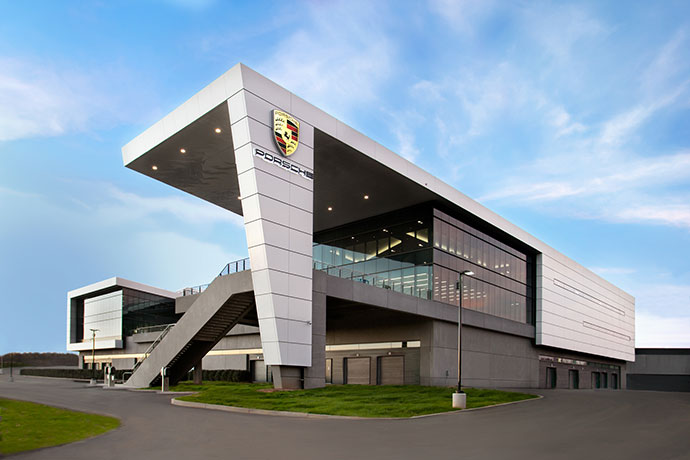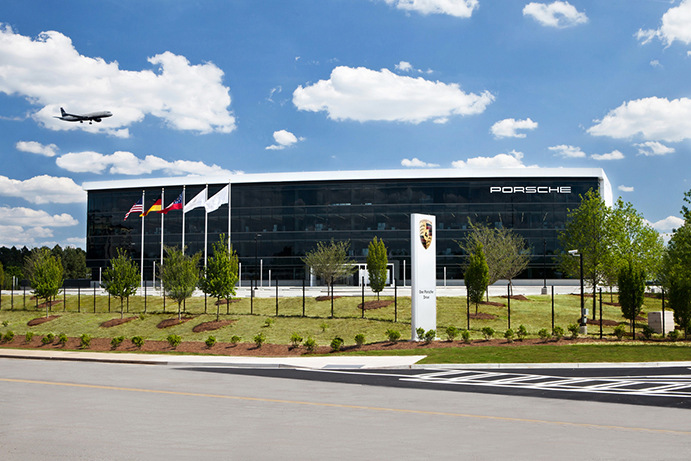You’ll find them in Paris, Hong Kong, Dallas-Fort Worth, Amsterdam. Even Stockholm, Manchester and Orlando. Airport cities — or their larger counterparts, aerotropolises — have sprung up around airports in these and many other locations in recent years. But it hasn’t happened in Atlanta, home of the world’s busiest airport by passengers — Hartsfield-Jackson Atlanta International Airport (HJAIA) reached the 100 million annual passengers mark in December 2015 — until now. Metro Atlanta-based Site Selection has covered airport developments for more than a decade, but only now can we report on progress at its home airport, as the Atlanta Aerotropolis Alliance, organized in very recent years, gains altitude.
It’s not that local leadership didn’t try. Atlanta Regional Commission Executive Director Doug Hooker has been championing the notion for more than a decade. Public officials in the municipalities surrounding HJAIA, economic developers with the state and at Georgia Power, airport management and other stakeholders know well the economic engine that the airport is — it contributes more than $32 billion to the region’s economy and is directly responsible for 63,000 jobs.
When Jupiter Aligns with Mars
It’s happening now for two reasons. First, the planets have finally lined up, the biggest of which was Porsche Cars North America’s decision to build its North American headquarters and Experience Center (test track included) on a former Ford assembly plant site adjacent to HJAIA that was rehabilitated by Jacoby Development. That project, which opened in January 2015, puts a premier automotive brand’s signature North American facility in the heart of the Atlanta Aerotropolis.
Second, the various stakeholders in the future development of the region surrounding the airport are now using the same telescope to view the future of the south side of Atlanta. The lion’s share of corporate investment in the Atlanta area has been demonstrably on the north side.
Speaking of planets, there isn’t an area considering, building or reaping the benefits of an airport city on this planet that Dr. Jack Kasarda is not familiar with, including Atlanta’s. Kasarda, director of the Center for Air Commerce at the University of North Carolina’s Kenan-Flagler Business School, and co-author of Aerotropolis: The Way We’ll Live Next (2011), has met on four occasions with stakeholders mulling an Atlanta aerotropolis.

“Although my presentations and meetings with stakeholders generated interest and a fair amount of enthusiasm, limited follow-up occurred,” Kasarda relates. “There was no champion and little coordination among the various stakeholders and government entities. To the contrary, there seemed to be competition among the government units and little desire to plan or operate as a unified group. No municipality appeared to want to give up their local planning autonomy for a greater aerotropolis effort.”
Therein lies the doom of countless airport city initiatives. But cooler heads prevailed here, including College Park, Ga., Mayor Joe Longino, whose town abuts HJAIA. The mayor is firmly of the opinion that his and other local municipalities should be working as one entity to welcome capital investment, whether it ends up in his town or an adjacent one. When one town lands a Porsche Cars North America and its 400 employees, they all benefit. It likely would have happened anyway, eventually. But by all accounts, the Porsche project was the catalyst.
“Organic aerotropolis development commenced,” says Kasarda. “The Atlanta Regional Commission began a coordinating effort with a broader public-private Aerotropolis Steering Committee that was formed along with an airport area development Chamber. The communities around the airport also recognized the importance of ATL driving their economic transformation and that they were in this together, benefitting much more by cooperating as an integrated aerotropolis entity, even if this meant possibly relinquishing some local planning autonomy. At the same time, the real estate community, some of whom held large tracts of open land near ATL, realized that they were sitting on a potential development gold mine.” Duke Realty’s Camp Creek Business Center, for example, is a 400-acre, 2.9 million sq. ft. (162-ha, 269,419 sq. m.) office and industrial development just three miles from the airport entrance. Land Rover, Jaguar, Primerica and the FAA are tenants, and there’s plenty of room for additional development at the location.
“All these factors converged to give structure and momentum to the Atlanta Aerotropolis planning and development effort in the past two years. I’m optimistic that the aerotropolis effort will succeed and harness the full economic potential of Hartsfield-Jackson for the greater prosperity of Atlanta, the airport’s surrounding municipalities and, indeed, the entire Atlanta region.”
We’re All in This Together
Mayor Longino’s take: “As mayor for 21 years, I’ve always said that what goes on at the airport drives the whole region, and it has to drive what’s close to the airport as well. Airport-related [enterprises] are easy givens. The hard givens are investments like Porsche — they chose to be out here because of proximity to the airport, and I’m finding that more and more organizations are looking at being closer to the airport.
“What’s good for College Park is good for the region,” the mayor continues. “And what’s good for another jurisdiction is also good for College Park. But Porsche being on the outskirts of Hapeville, actually in Atlanta but with a Hapeville address, is good for the region, because it has brought a player to the table that has never been at the table in the southern crescent. Nobody abroad knows where Cobb County is or where College Park is. But everyone knows where Atlanta is, so you have to identify yourself with Atlanta when you’re marketing yourself so people know where you are.”

The Atlanta Aerotropolis Alliance is an effective way to do that, combining Atlanta with its unrivaled air hub assets and the sense of place “Aerotropolis” evokes. That’s why the cities of College Park, East Point, Hapeville and Atlanta, Clayton County, the South Fulton Chamber of Commerce, among other municipal entities, are on board. Besides Porsche, corporate members include SunTrust, Chick-fil-A, Delta Airlines and Georgia Power. Their involvement is the key.
“Development doesn’t happen at the city or county level but at the corporate level,” says Mayor Longino. “The Chick-fil-As and the Porsches and the Kias help foster great things happening in regions.
Porsche coming to this site was the catalyst. I give [Porsche Vice President, Secretary and General Counel] Joe Folz a lot of credit. He saw that we need to attract other companies and help make it an Aerotropolis. When Porsche announced they were going to build where they did, people wondered if it would hurt College Park. Absolutely not! What’s good for Hapeville is good for College Park.”
And more investment is good for the entire region, he reiterates. “That’s one of the things Aerotropolis Alliance can foster. I’m excited about what we’ve already done, but we’ve only scratched the surface.”
Porsche in the Driver’s Seat
Joe Folz was the first chairman of the Atlanta Aerotropolis Alliance, from March 2014 through 2015, a role he eagerly took on.
“This has really been the dreamchild of the Atlanta Regional Commission for a very long time,” Folz tells Site Selection. “Doug Hooker had the dream more than a decade ago of the Atlanta Airport area being so much more than it has ever been. He understood that the business community was going to be the driver of whatever happens here — taking advantage of tremendous natural resources, tremendous man-made infrastructure that is already here and trying to persuade businesses to bring great jobs to a very underused area of the community and underused people and resources.”
Why not political leadership?
“The people who are going to create jobs are private enterprise, and nobody talks the language of business like other businesses. I don’t have any illusion that I was asked to become involved in the Atlanta Aerotropolis Alliance for any reason other than that I have Porsche on my business card. It was really important that the major businesses that are already operating successfully in the aerotropolis area become a huge part of the effort to expand what we are doing. It was critically important that Porsche become involved, and it was critically important to Porsche as well. It was also important that Delta and Chick-fil-A along with Duke Realty and Georgia Power be very involved. We were the nucleus. We were able to persuade people that we were serious and establish what is starting out to be a very effective coalition.”
The new complex by Hartsfield-Jackson is the second time Porsche chose Atlanta for its North American headquarters, Folz relates. After 14 years in Reno, Nev., the automotive management staff moved into office space in Atlanta’s Central Perimeter office market in 1998; the financial management team went to Chicago. But the CEO at the time envisioned a more Porsche-like headquarters, complete with Experience Center and test track. The site had to be in the Eastern time zone for proximity to Europe, and preferably in the Southeast, where the weather would permit greater use of the outdoor amenities.
Out by the Airport?
“We looked at over 70 sites in several states,” says Folz. “We were not unhappy at all in Atlanta. All the reasons we came here in the first place were still valid, and recruiting people to come to Atlanta was never difficult. Most of the places we looked at were a bit remote from population centers, because that’s where you can build a test track. That is our single most important marketing endeavor, and it must be completely self-sustaining. That required finding a location where we could attract between 25,000 and 35,000 unique visitors each year and where we could attract other businesses to come and have corporate meetings and use the experience center as a recreational activity.”

Folz and his team entertained lots of proposals, but there was something about the Jacoby site and its proximity to the airport and to Atlanta’s business center that kept them on the hook.
“A lot of people told us the site would never work, in part because of the number of competing jurisdictions in that part of town — the 58 acres we own are in multiple jurisdictions. The FAA has control over what happens near airports, everyone told us in theory that might work, the zoning is correct, but practically speaking, it won’t happen. And frankly there was a sense that the airport area of Atlanta was not a place for a company like Porsche. But the way Porsche does business is if you tell us something can’t be done, that makes us more intent on finding a way to do it. For many reasons, it was just meant to be, notwithstanding the difficulties.”
It worked, says Folz, because everyone involved wanted it to work, even the FAA, which carefully scrutinizes all development plans near airports, especially the world’s busiest. “We were told the FAA would shut down the project, but they have been the most enthusiastic supporters — they love a challenge and the opportunity to work on something that was unlike anything else. Between the Porsche name and image and the excitement of the idea of the test track, everyone we talked to was intrigued by the project — they took our calls and wanted to meet with us. People wanted to be a part of it. That gave us a tremendous advantage that a lot of companies would not have had. Everyone cooperated extremely well.”
Therein lies the point of the Atlanta Aerotropolis Alliance — to make it easier for capital investors that lack the cachet of the Porsche brand to locate facilities in a part of Atlanta they may not have considered. Only then will the area truly take off. Only then will Porsche’s gamble on a former auto assembly plant site for its North American headquarters and Experience Center in the less-than-glamorous Atlanta airport neighborhood be truly successful.
“We have said from the beginning that we know this project is unconventional, and we are absolutely willing to be the first,” says Folz. “But we cannot afford to be the only project. If Porsche is nothing but a shining outpost in the area, then we will have failed. If all that happens here is people come in the morning and go home at night, we will have failed. If we do not attract a critical mass of people who help the upward spiral of more amenities — more restaurants, hotels, other attractions, businesses that create good jobs, which is really what will change the south side of Atlanta, then we will have failed. That’s the reason we are so strongly supporting the Aerotropolis Atlanta development. We have got to do our part to make this an upward spiral. The success of our business depends on this becoming the next thriving live-work-play area of Atlanta.”

